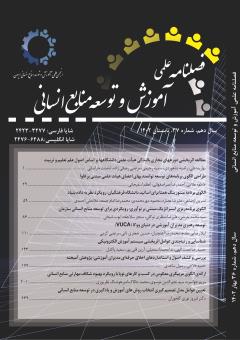شناسایی و رتبه بندی عوامل اثربخشی سیستم اموزش الکترونیکی
محورهای موضوعی : روش های نوین آموزش وتوسعه منابع انسانی
حمیدرضا نعمت الهی
1
![]() ,
ندا محمداسمعیلی
2
,
ندا محمداسمعیلی
2
![]() ,
آرین قلی پور
3
,
آرین قلی پور
3
![]() ,
سعید پاکدل
4
,
سعید پاکدل
4
1 - کارشناسی ارشد، گروه رهبری و سرمایه انسانی، دانشکده مدیریت، دانشگاه تهران، تهران، ایران
2 - استادیار، گروه رهبری و سرمایه انسانی، دانشکده مدیریت، دانشگاه تهران، تهران، ایران
3 - استاد، گروه رهبری و سرمایه انسانی، دانشکده مدیریت، دانشگاه تهران، تهران، ایران
4 - نایبرئیس انجمن علمی آموزش و توسعه منابع انسانی
کلید واژه: آموزش الکترونیکی, یادگیری, بهبود آموزش الکترونیکی, اثربخشی آموزش الکترونیکی, روش آمیخته,
چکیده مقاله :
اخیراً توجه زیادی به آموزش الکترونیکی در نظام آموزشی شده است این نظام آموزشی از عواملی تشکیل شده است که تأثیر بسزایی در موفقیت فرایند آموزش الکترونیکی دارند و منجر به ارتقا یا کاهش کیفیت سیستم آموزش الکترونیکی میشود. این مقاله با بهرهگیری از روش آمیخته ابتدا با استفاده از روش تحلیل مضمون، به دنبال ارائه دستهبندی جامعی از عوامل اثربخش در سیستم آموزش الکترونیکی بوده و سپس با استفاده از روش تاپسیس به دنبال رتبهبندی آن عوامل بوده است. از دیدگاه هدف، پژوهشی کاربردی و از نظر زمان پژوهش مقطعی است. مشارکتکنندگان در پژوهش کارکنان، اساتید و دانشجویان مقاطع مختلف در رشتههای گوناگون دانشگاه تهران بودهاند که بهصورت هدفمند و از نوع حداکثر تنوع انتخاب شده و بعد از اشباع نظری به تعداد 15 نفر رسیدند. گردآوری دادهها نیز از طریق مصاحبههای نیمهساختاریافته انجام شد. با تحلیل یافتههای بهدستآمده 43 مضمون سازماندهنده از کدها استخراج شد که با فرایند رفتوبرگشت محققین به 6 مضمون اصـلی یا فراگیر دست یافتند. در نتیجه رتبهبندی نیز عوامل: استانداردسازی آموزش الکترونیکی، تعامل محتوا، مستندسازی و نظارت بر آموزش و عوامل پداگوژی و طراحی آموزشی داری بیشترین تأثیر و عوامل: افزایش سودمندی درک شده، ارتقا فردی و مهارتی و یادگیری شبکهای دارای کمترین تأثیر هستند.
Electronic education and learning is one of the subjects which has recently received great attention in the educational system. Hence it is important to investigate the factors that have a significant impact on the success of the electronic education process and lead to the improvement or reduction of the quality of this educational system. In this regard, the present study ought to provide a comprehensive classification of effective factors in the e-learning system by using the mixed method. First, this study by using the mixed method (theme analysis) method, tried to provide a comprehensive classification of effective factors in the e-learning system, and then by using TOPSIS method the factors were ranked. With regard to the goal, this was an applied research and in terms of time it is a cross-sectional. The participants in the research were employees, professors and students in different fields of Tehran University. 15 individuals were selected after theoretical saturation and the data was collected through semi-structured interviews. By analyzing the obtained data, 43 organizing themes were extracted from the codes, and with further consideration the researchers reached 6 main and comprehensive themes. As the result of ranking revealed, the factors including standardization of e-learning, content interaction, documentation and monitoring of education, and the factors of pedagogy and educational design have the greatest impact, and the factors including increase in perceived usefulness, personal and skill improvement, and network learning have the least impact.
